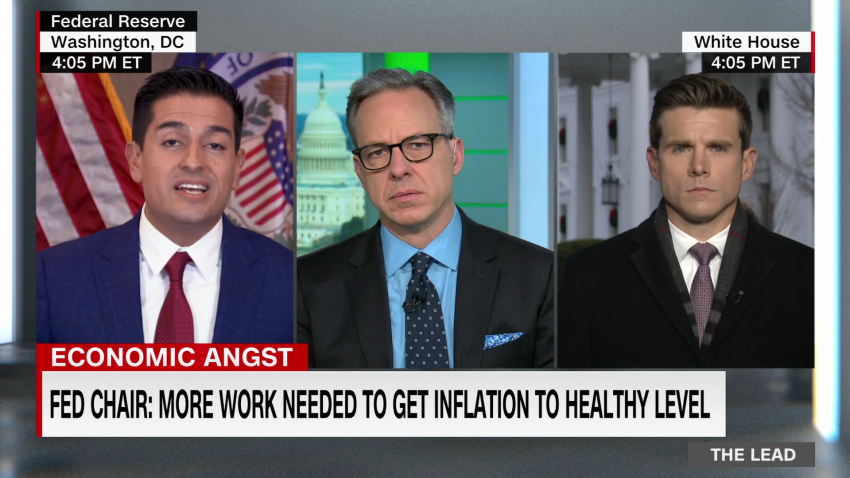For the first time in nearly three years, inflation fell on a monthly basis.
Consumer prices decreased by 0.1% in December, the Bureau of Labor Statistics reported Thursday in its Consumer Price Index. The last time prices were lower than the previous month was May 2020.
The closely watched inflation gauge also showed that year-over-year prices continued to cool last month, slowing to 6.5%, from 7.1% in November. It’s the smallest annual increase since May 2021.
Stripping out food and energy prices, which tend to be more volatile, core CPI came in at 5.7%, down from November’s 6% annual rate and up 0.3% from the month before.
“It all adds up to a real break for consumers, real breathing room for families and more proof that my economic plan is working,” said President Joe Biden on Thursday. “We have more work to do, but we’re on the right track.”
Brian Deese, Biden’s top economic adviser and head of the National Economic Council, told CNN’s Kate Bolduan that the latest report and the downward trajectory in prices over the past several months is “encouraging,” especially considering the latest jobs report, which showed the economy added 223,000 jobs in December and unemployment fell to 3.5%.
“We’re seeing that kind of moderation that we want to see, and importantly, we saw it in the context of a quarter where our labor market remained resilient,” he said. “We hit the lowest unemployment rate in 50 years in this country, and workers are seeing real wage increases.”
Thursday’s report was the first inflation report of the new year — and the last before the Federal Reserve meets at the end of the month to determine how aggressively it will tackle rising costs.
“Today’s CPI reading is another sign that inflation is heading in the right direction and indicates the peak is likely in the rear view,” said Mike Loewengart, head of model portfolio construction at Morgan Stanley Global Investment Office.
However, we aren’t “out of the woods yet,” he said. Annual core CPI is well above the Fed’s 2% target rate.
“The Fed has remained adamant that they will keep rates high to bring inflation back to normal levels,” he added.
Prices on a roller coaster ride
2022 was a rickety ride for Americans. Prices skyrocketed during the first half of the year, with inflation hitting 9.1% at its crest in June. It’s been coasting downward in the months since.
Economists had expected the latest CPI data to show softness, given that gas prices are down from their painful record high this summer.
Thursday’s CPI report showed just that … and then some. The prices for regular unleaded gasoline fell 9.6% from November, helping to contribute to a 2% year-over-year price drop, which is the category’s first annual price decline since January 2021.
More palatable pump prices aside, inflation’s ease has been seen across a broad swath of sectors.
Durable goods were some of the first to see a slowing in price hikes, followed by non-durables — products with a lifespan of under three years — said Kayla Bruun, economic analyst at Morning Consult.
However, food prices have remained stubbornly higher — a trend expected to continue through much of this year — and there is ongoing concern about inflation within the services sector.
“Demand for services really seems to be slowing down as well,” Bruun said. “We’ve seen a sharp increase in price sensitivity and trading down, so that just overall translates to consumers just becoming a lot more budget-conscious — not just with goods as they were for a lot of the last year, but with services increasingly as well.”
That includes shifting dining out money back to the grocery store, curtailing travel plans, and cutting back spending overall, she said.
Eggs nearly 60% higher
Prices for used cars and trucks, airline fares, and hospital services fell from November to December, while the pace of prices increases in other key areas moderated. Most notably, food prices grew at the smallest monthly rate since March of 2021, BLS data shows.
“This month, food [at home] prices rose just two-tenths of a percent. That’s a big deal in terms of people’s pocketbooks,” said Dean Baker, economist and co-founder of the Center for Economic and Policy Research.
But that’s still higher than overall inflation, with prices up 11.8% annually in December and certain products considerably higher.
Egg prices, which have skyrocketed in part due to an outbreak of avian flu, were 59.9% higher in December than the year before — the highest annual increase for egg prices since 1973.
Biden acknowledged that price increase Thursday, saying: “Last month, we saw the smallest increase in food prices in almost two years, and much of that increase was due to the avian flu outbreak, which has driven up the egg prices around the United States.”
Outlook for the Fed
Still, other pricing trends bode well for overall inflation and for the broader economic picture, said George Calhoun, economics professor and director of the Quantitative Finance Program at the Stevens Institute of Technology in New Jersey.
“If you take the month-over-month numbers since July and annualize that, the annually compounded monthly rate has been around 2%, right at [the Fed’s target],” Calhoun said. “I think inflation is actually over, and what we have with the year-over-year metric is a built-in lag in recognizing that.”
Economists anticipate that the Fed will continue to slow the pace of its rate hikes in 2023. However, the end of the tightening cycle is still “some ways off,” said Cailin Birch, global economist at the Economist Intelligence Unit.
The drop in the headline number was largely due to energy prices falling, and further declines in global oil prices aren’t expected in 2023, she said in a statement. In addition to food prices still being on the rise, core inflation picked up 0.3% in December from November.
“This steady increase is more a cause for concern, as it reflects the impact of still-strong consumer demand, the trickling through of higher input costs and rising wages,” she said.




